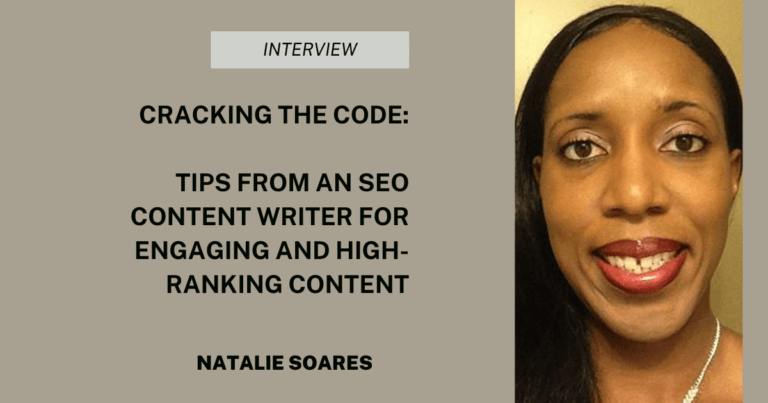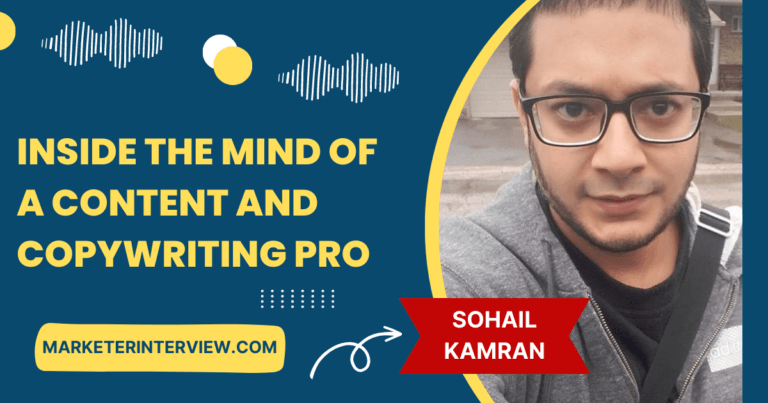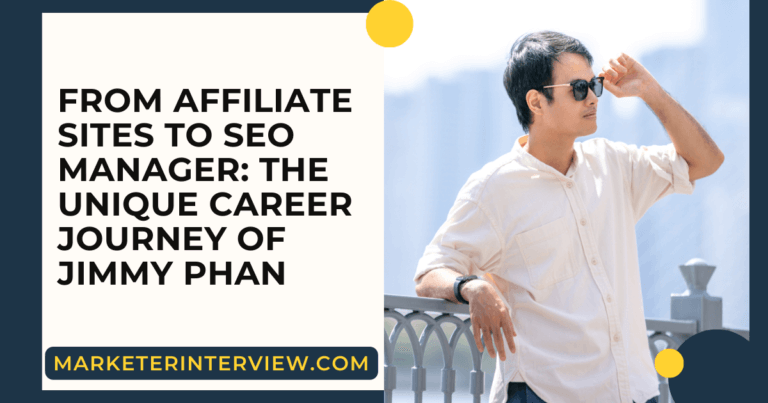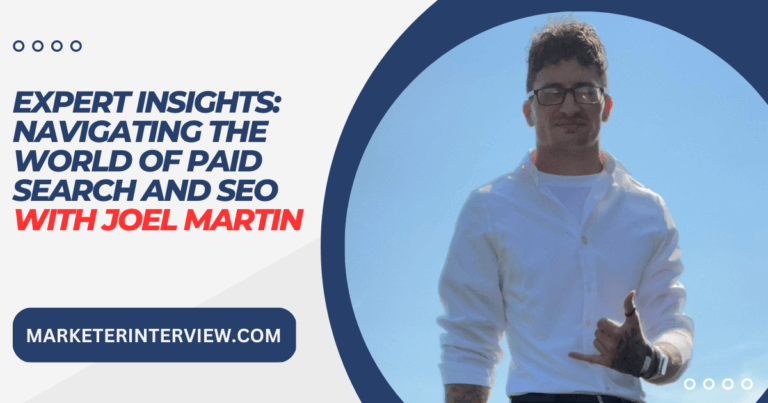People-Centric Content: An Interview with Rohit Ganguly
Welcome to another captivating interview on Marketer Interview!
Today, we’re thrilled to have Rohit Ganguly, a Marketing Associate with a unique content creation and strategy approach. Unlike the conventional tech company approach, Rohit’s focus on highlighting the people and culture of his company has set him apart in the industry.
Join us as we discover his journey, experiences, and insights in content marketing.
Contents
- 1 Can you tell us about your journey into the field of marketing and how you found your niche in content creation?
- 2 Your role seems distinct. Could you elaborate on how your approach to highlighting company culture through content differs from traditional tech companies?
- 3 What sparked your interest in creating people-centric content, and how does it impact your company’s brand and image?
- 4 Could you share an example of a particularly memorable article you’ve written that captures a real person’s journey within your company?
- 5 Your expertise spans from SEO-optimized content to scriptwriting. How do these skills complement your role as a Marketing Associate?
- 6 Please walk us through your content development process, from SEO research to the final polished piece.
- 7 With your experience in various writing formats, such as YouTube scripts and product slogans, how do you adapt your style to suit different platforms and audiences?
- 8 You’ve mentioned project coordination and engagement with multiple stakeholders. How does this collaborative aspect influence your content projects?
- 9 Among the CMS platforms you’ve worked with, like WordPress and HubSpot, which do you find most effective for content dissemination, and why?
- 10 Could you share your go-to tools and software for content creation and marketing tasks? How do they enhance your efficiency?
- 11 Your journey spans across publishing, SEO, advertising, and more. How have these experiences contributed to your versatile skill set and creative perspective in content marketing?
Can you tell us about your journey into the field of marketing and how you found your niche in content creation?
I stumbled upon marketing as a career.
I started my career as a content writer and creator for an application for students. Did voiceovers, a bit of video editing, and in-person quizzes.
I never had a strict boundary in my mind about what I was going to do.
Then came SEO-based writing for clients in the US, Australia, and the UK. That was a despairing experience because I had to write 2-3 articles daily. Nightmarish.
But I wanted to explore more. Beyond the bounds of what the 9-5 job offered. So, my wife and I started this YouTube channel called Food Trails.
I learned the basics of building a website using a CMS (WordPress), buying a domain, and setting up analytics tools in Google from scratch, a lot of trial and error. We no longer invest regular time and effort into that project, but it did teach me a lot about how marketing for a company looks from a birds-eye view.
I used that knowledge to get freelancing clients. Even though it might seem like a waste of resources sometimes, investment in learning and growing never goes to waste.
My current role came as a surprise. The credit for envisioning the role goes to Axelerant’s Marketing Director, Nathan Roach, and Senior Marketing Manager Sharayu Thakare. They needed to capture the stories of people at Axelerant who could lead empowered, balanced, and happy lives, overcoming significant personal challenges.
This role perfectly aligned with my belief that behind every successful company or team is a group of happy, well-looked-after people. People are the fulcrum over which a successful organization rises. There was something else. My role is the perfect amalgamation of journalism and marketing for any writer because I interview people personally and tell their truth while highlighting how Axelerant makes it possible.
Your role seems distinct. Could you elaborate on how your approach to highlighting company culture through content differs from traditional tech companies?
Traditionally, tech companies strongly emphasize how their products and services help solve their customers’ or clients’ problems. The emphasis on the company’s impact on its people, and how associating with them transform their lives, is staggeringly nonexistent.
It’s almost like—a steady job and good projects should be more than enough for people considering joining them. So, naturally, most companies don’t feel the need to invest in their people’s holistic wellbeing. Or in cultivating an empowering, supportive work culture.
I am fortunate to have been working at a place where that investment is made. And several team members have benefited from having a people-centric culture.
My work here is basically to create content by capturing the truth. Is it always pleasant and appealing to the eye? No. But that’s where I come in. I capture the truth using words and images and make it appealing enough that people stick to the story until the end.
And it’s not just about highlighting the organization that I work in. The topics that I cover are critical in the entire industry. For instance, I did a story about imposter syndrome by interviewing one of the directors at Axelerant. They came forward, which takes guts, and shared the struggles and wins against this condition.
So we’re not only just creating content over here. We are talking about things that people are uncomfortable discussing openly. And we are also talking about what we are doing to address these difficult things.
What sparked your interest in creating people-centric content, and how does it impact your company’s brand and image?
The idea to create people-centric content wasn’t mine per se. But during the interview, when I heard about the idea that this is something the marketing team was considering, it immediately caught my attention.
My interest in creating people-centric content, especially those revolving around real peoples’ tales of triumph, resonates with my core personal belief system.
People should love and respect others rather than focusing on their drawbacks and contemplating ways of competing against one another.
It doesn’t need to be like that. So, I focus heavily on capturing uplifting stories of real people so that others in their shoes can feel motivated towards a better life. Or at least to talk about their issues without fear of judgment.
The work that I am doing has a powerful impact not only on the company’s brand and image but on the industry as a whole. The topics I choose often come from honest discussions with someone in the software engineering industry.
For example, I explore work-life flexibility in one article through an Axelerant director’s professional journey. I got the idea for that topic from my discussions with engineers working in big tech companies who are expected to work at least 12-14 hours a day, often stretching well beyond midnight.
Moreover, I have also applied this people-centric approach in my email copies. And people have reached out to our team and expressed the feeling of being heard over DMs.
The bedrock of my marketing approach is empathy. When you genuinely empathize with the person you write for, it will connect with them. Because you are taking away all the pretense, the gimmick, and talking to another person – someone just like you but in a different situation.

Sure. This article about work-life flexibility comes to mind first.
This is Axelerant’s Director of Global Delivery Hetal Mistry’s story. This article covers her experiences of working in the Indian tech industry, not the sugarcoated version you see in most LinkedIn bios.
This is the real picture of the industry, with its highs and lows. It also captures how she took a chance by joining Axelerant to improve her life. Because at one point, it had become unbearable, which, by the way, is the reality for many engineers around the world.
From struggling to keep work commitments, she found a place to care for her children and sick husband and work without being judged or sidelined.
Your expertise spans from SEO-optimized content to scriptwriting. How do these skills complement your role as a Marketing Associate?
Digital marketing is a vast industry with an incredible scope for growth and learning. So, whatever skills I have picked up over the years come in handy intermittently. You never know when an interesting project comes along. If you have the skills, you can tag yourself along.
The underlying thread that connects all my skills is my ability to communicate ideas and messages in words. I see that ability like water: it can fit into any shape as long as it maintains its fluidity. That’s the complementary factor.
Catching hold of that thread, I learn new things periodically. For instance, right now, I am learning HubSpot email marketing. The automation sequencing bit is a little technical, but I enjoy it now and then.

Please walk us through your content development process, from SEO research to the final polished piece.
My current articles are not very SEO-dependent. I capture stories of real people. The topics depend on the people’s journeys.
For instance, I may be writing about a woman’s fitness journey, to transform her life and achieve some deeply personal goals. In such cases, I strongly focus on the story, capturing the essence of it. The process for me looks more like that of a writer right now.
But if I am writing on a topic with a high opportunity to be SEO optimized, I use the premium version of SEMrush to research. The keywords that I search for depend on the list of topics that I want to include my organization’s brand with, like remote work, work culture, etc. Google’s shift of focusing on the intention and consumability of content more than specific keywords has been helpful for content creators like me.
Currently, I set up and take interviews with the people whose stories I plan on covering. I use StreamYard for this. Then, I convert the whole story into an article with utmost respect for privacy. It’s like sculpting with words. You omit and keep just the precise parts of the story that create a riveting impact on the reader’s mind.
With your experience in various writing formats, such as YouTube scripts and product slogans, how do you adapt your style to suit different platforms and audiences?
Well, every platform has a specific way of communicating. It evolves from time to time. But that specificity remains intact.
I’ll give you a very nuanced example. The way people comment on YouTube videos and shorts differs from the comments on Instagram reels. People may not consciously understand that they conform to these nuances, but most heavy social media users understand these subtle differences.
I focus on the scope of the touchpoint— how much time someone will have when reading a piece of content, what their surroundings will be like, and what kind of energy the reader will have going at the time.
Once I figure out their situation while consuming the content, I answer the two most important questions while writing anything.
1. What is my primary objective from this content?
2. What feelings am I trying to evoke in the reader?
Every word I choose, the length, and the tone will depend on these answers.
You’ve mentioned project coordination and engagement with multiple stakeholders. How does this collaborative aspect influence your content projects?
There are types of content that one can create individually with little effort or input from others. But that is only sometimes possible when you’re part of a company’s team. There are always collaborators (I do not prefer the word “stakeholders” for its gory undertones) for ideas, reviews, designs, edits, etc.
Collaborating with others is always a positive experience, at least where I am now. When many people bring unique skills and perspectives to a project, it makes the project all the more impactful. At least, that has been my experience.
But frankly, I have also seen in my experience that when the synergy is off, and people are out competing with each other, clashing egos, collaboration doesn’t work. Or, even if it does, it is a pain.
Among the CMS platforms you’ve worked with, like WordPress and HubSpot, which do you find most effective for content dissemination, and why?
I’ve found both WordPress and HubSpot pretty handy to work with. But I must give it to HubSpot simply because of their support team. They make Loom videos to explain and solve your queries and offer top-class service. Every time I walk away feeling good.
In terms of content dissemination, I gravitate towards HubSpot, too. Though WordPress is not behind either. HubSpot lets you customize so much. Integration with other software platforms is also easy.
StreamYard and Zoom for taking interviews.
SEMrush for SEO research for when it’s needed.
Otter.ai for transcribing video recordings.
Grammarly for weeding out silly mistakes. They have developed their AI support option, which is quite good. You don’t need to train it all that much.
I’ve recently started using ChatGPT. It’s not the professional version. The free one. I play around with it sometimes.
These tools make my work much easier and faster to do. I can’t even imagine transcribing interviews manually. That would be a huge drag.
But it’s important to have a strong grasp of the language, its nuances, to use these tools and not become blindly dependent on them. That’s important.
Your journey spans across publishing, SEO, advertising, and more. How have these experiences contributed to your versatile skill set and creative perspective in content marketing?
The focus evolves with each new experience. Initially, the focus was always on getting the work done, then getting the work done with minimum errors. Then, with quality and integrity.
And now, having all of these experiences, my understanding of marketing has evolved to a place where I focus on empathy in communication. Whatever the format. And I focus on the overall experience more than individual moving parts, which in industry terms is also called marketing collaterals.
What does it look like in real life? I love words. But if I see, in a particular project, a simple, two-line voiceover with a blank white screen can create the intended feeling in the viewer or reader? Then, I would instead go with the second option.






